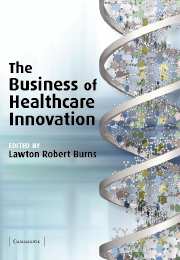Book contents
- Frontmatter
- Contents
- List of figures
- List of contributors
- Preface
- Acknowledgments
- 1 The business of healthcare innovation in the Wharton School curriculum
- Part I The life sciences
- Part II Devices and information technologies
- 6 The medical device sector
- 7 The healthcare information technology sector
- 8 Healthcare innovation across sectors: convergences and divergences
- Index
7 - The healthcare information technology sector
Published online by Cambridge University Press: 22 September 2009
- Frontmatter
- Contents
- List of figures
- List of contributors
- Preface
- Acknowledgments
- 1 The business of healthcare innovation in the Wharton School curriculum
- Part I The life sciences
- Part II Devices and information technologies
- 6 The medical device sector
- 7 The healthcare information technology sector
- 8 Healthcare innovation across sectors: convergences and divergences
- Index
Summary
Introduction to information technology
Healthcare information technology (IT) is expected to be almost a $100 billion business worldwide by 2005, comparable in scale to a Latin American economy. It is also an industry in transition, from early applications which supported batch processing of financial transactions to sophisticated, artificial intelligence-assisted real time clinical process control. This chapter will discuss the size and organization of this important sector, review the major applications developing in healthcare information technology, and also look at the barriers to adoption and use of these important technologies.
Over the next decade, of all technologies that affect the healthcare experience, information technology holds the greatest potential for yielding positive changes for patients and their families – more rapid and accurate diagnoses, fewer medical errors, and less wasted time from duplicative information requests in the treatment and payment process.
While overall IT spending faltered in the wake of the collapse of the Internet bubble, healthcare IT spending has continued growing in the United States, and is expected to accelerate due to pressure from payers to improve clinical quality and outcomes.
However, even at its current levels, healthcare IT spending in the US represents only about 2.5 percent of overall health expenditures, a percentage which is less than half of that in other industries such as financial services or retailing. Healthcare IT spending is likely to grow at a near double digit rate for at least the next decade worldwide (see figure 7.1).
- Type
- Chapter
- Information
- The Business of Healthcare Innovation , pp. 322 - 347Publisher: Cambridge University PressPrint publication year: 2005

